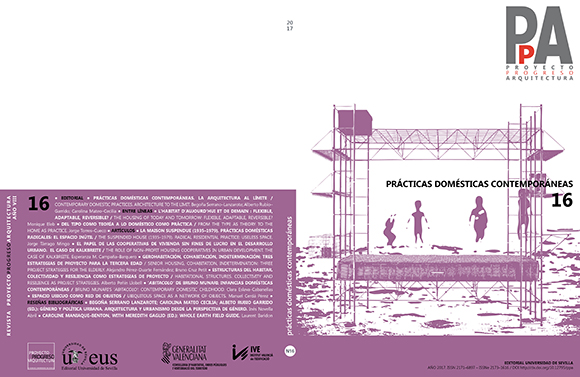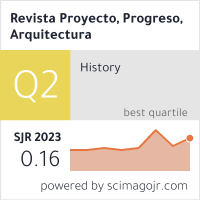ESTRUCTURAS DEL HABITAR. COLECTIVIDAD Y RESILIENCIA COMO ESTRATEGIAS DE PROYECTO / HABITATIONAL STRUCTURES. COLLECTIVITY AND RESILIENCE AS PROJECT STRATEGIES
DOI:
https://doi.org/10.12795/ppa2017.i16.06Palabras clave:
Vivienda, cohousing, resiliencia, proyecto, años 60 / housing, resilience, project, 1960sResumen
RESUMEN En el escenario social y urbano contemporáneo, el debate sobre la vivienda ocupa una posición central. Tras constatar algunas de las trazas más relevantes de este contexto, el artículo indaga en la constelación de las nuevas propuestas arquitectónicas que le dan respuesta proponiendo una agrupación que describe al menos dos instrumentos del proyecto arquitectónico. Uno se ocupa de su contenido, donde destacarán las experiencias de la vivienda compartida; el otro, en contraposición, se preocupa de definir sus mínimos elementos estructurantes, y que daremos en llamar la vivienda resiliente. Se manifestará de maneras diversas; vivienda progresiva, inacabada, rehabilitada, adaptable etc. En ambos casos no se trata sino de la sistematización de prácticas previas, en las que llama la atención una suerte de continuidad histórica entre el umbral de los siglos XIX y XX, los años 60 y el período contemporáneo, interrumpidos por momentos de un crecimiento acrítico. Estas nuevas estructuras del habitar, a diferencia de las épocas anteriores, se integran hoy de manera articulada en el proyecto contemporáneo poniendo en cuestión sus límites, legales y de autoría, y abriendo el campo a la investigación académica. En última instancia, el artículo propondrá algunos mecanismos proyectuales que permitirán caracterizar y fomentar estas nuevas estrategias.
SUMMARY In the current social and urban scene, the discussion on housing plays a central role. After identifying some of the most relevant concepts in this context, the article explores the myriad of new architectural proposals that have emerged in response to this question, and suggests a grouping method that describes, at least, two different tools for the architectural project. The first of them is related to content, here we will highlight some shared housing experiences; the second, on the other hand, focuses on defining the minimum structuring elements; we have called it the resilient dwelling. It will take many different forms; progressive, unfinished, refurbished, adaptable dwelling, etc. In both cases, it is but a matter of systematizing previous experiences, among which it is remarkable a sort of historic continuity between the late nineteenth and early twentieth centuries, the 1960s, and the contemporary era, interrupted by periods of non-critical development. Today, unlike in earlier periods, these new habitational structures integrate in contemporary projects in an articulated manner, questioning its limits, both legal and in regards to authorship, and opening up the field for academic research. Lastly, the article proposes some project mechanisms that will help characterize and promote these new strategies.
Descargas
Citas
BUSTOS, Xavier, ed; REGUSCI, Nicola, ed. Connection_Import Zúrich. Cooperative housing: new ways of inhabiting. Barcelona: Dpr–Barcelona, 2016.
DIAZ–RECASENS, Gonzalo. Golden Lane. Sobre la cualidad vacía del espacio público en la obra de los Smithson. En: Proyecto, progreso, arquitectura. Vivienda colectiva. Sentido de lo público. Sevilla: Editorial Universidad de Sevilla, noviembre 2011, nº 5, pp. 60–71. ISSN 2171–6897. DOI: http://dx.doi.org/10.12795/ppa.2011.i5.04.
DRUOT, Frédéric; LACATON, Anne ; VASSAL, Jean–Philippe. PLUS, les grands ensembles de logements. Territoires d’exception. Barcelona: Gustavo Gili, 2004.
EBERLE, Dietmar. Entrevista en Palimpsesto. Barcelona: Editorial Palimpsesto, septiembre 2016, nº15, pp. 2–4. ISSN 2014–1505. DOI: 10.5821/palimpsesto.15.4811.
HOFER, Andreas; HUGENTOBLER, Margrit. More than housing. Cooperative planning–a case study in Zúrich. Basel: Birkhauser, 2016.
ITO, Toyo. Una arquitectura que pide un cuerpo androide. En “Escritos”. Murcia: Colegio Oficial de Aparejadores y Arquitectos Técnicos de Murcia, 2000, pp. 61–65.
GEHL, Jan. “Soft Edges” in residential streets. En Scandinavian Housing and Planning Research. Copenhagen: [s.e.], 1986, vol. 3, nº2, pp. 89–102. DOI: http://dx.doi.org/10.1080/02815738608730092. ISSN: 1403–6096
KAAN, Kees, Beyond Dogma [en línea] , Conferencia en Cátedra Blanca ETSAB 2014 [consulta 06–03–2017] Disponible en https://upcommons.upc.edu/handle/2099.2/3947.
KOOLHAAS, Rem. Delirious New York: A Retroactive Manifesto for Manhattan. New York: Monacelli, 1994.
MONTEYS, Xavier. FUERTES, Pere. Casa collage. Un ensayo sobre la arquitectura de la casa. Barcelona: Gustavo Gili, 2001.
NIETO FERNÁNDEZ, Fernando. El sistema como lugar. Tres estrategias de colectivización del espacio doméstico contemporáneo. En: Proyecto, progreso, arquitectura. Hábitat y habitar. Sevilla: Editorial Universidad de Sevilla, noviembre 2013, nº 9, pp. 50–67. ISSN 2171–6897. DOI: http://dx.doi.org/10.12795/ppa.2013.i9.03.
OTTO, Frei et al, ed. Arquitectura Adaptable. Seminario organizado por el Instituto de Estructuras Ligeras (IL). Barcelona: Gustavo Gili, 1979.
PUIGJANER, Ana María, Ciudad sin cocina: el Waldorf Astoria, apartamentos con servicios domésticos colectivos en Nueva York, 1871–1929. Director: Xavier Monteys. Tesis Doctoral. UPC. Departamento de Proyectos Arquitectónicos. 2014.
SABATER, Txatxo; MALDONADO, Josep, Gerohabitación, Cohabitación y Emancipación. Barcelona: Editorial Oficina Multimèdia Publicacions, ETSAV–UPC, 2009.
SMITHSON, Alison y Peter. The Charged Void: Urbanism, Londres: The Monacelli Press. 2004.
United Nations Secretariat and United Nations Centre for Human Settlements (Habitat), Compendium of Human Settlement Statistics 2001 (United Nations publication, Sales No. E.01.XVII.5), Compendium of Human Settlement Statistics 1995 (United Nations publication, Sales No. E.95.XVII.11) and United Nations, Compendium of Human Settlements Statistics 1983 (United Nations publication, Sales No. E/F.84.XVII.5).
Descargas
Publicado
Cómo citar
Número
Sección
Licencia
Las ediciones impresa y electrónica de esta Revista son editadas por el Secretariado de Publicaciones de la Universidad de Sevilla, siendo necesario citar la procedencia en cualquier reproducción parcial o total.
Salvo indicación contraria, todos los contenidos de la edición electrónica se distribuyen bajo una licencia de uso y distribución “Creative Commons Atribución-NoComercial-SinDerivar 4.0 Internacional” ![]() . Puede consultar desde aquí la versión informativa y el texto legal de la licencia. Esta circunstancia ha de hacerse constar expresamente de esta forma cuando sea necesario.
. Puede consultar desde aquí la versión informativa y el texto legal de la licencia. Esta circunstancia ha de hacerse constar expresamente de esta forma cuando sea necesario.
Los autores/as que publiquen en esta revista aceptan las siguientes condiciones:
- Los autores/as conservan los derechos de autor y ceden a la revista el derecho de la primera publicación, con el trabajo registrado con la licencia de atribución de Creative Commons, que permite a terceros utilizar lo publicado siempre que mencionen la autoría del trabajo y a la primera publicación en esta revista.
- Los autores/as pueden realizar otros acuerdos contractuales independientes y adicionales para la distribución no exclusiva de la versión del artículo publicado en esta revista (p. ej., incluirlo en un repositorio institucional o publicarlo en un libro) siempre que indiquen claramente que el trabajo se publicó por primera vez en esta revista.
- Se permite y recomienda a los autores/as a publicar su trabajo en Internet (por ejemplo en páginas institucionales o personales) antes y durante el proceso de revisión y publicación, ya que puede conducir a intercambios productivos y a una mayor y más rápida difusión del trabajo publicado (vea The Effect of Open Access).









